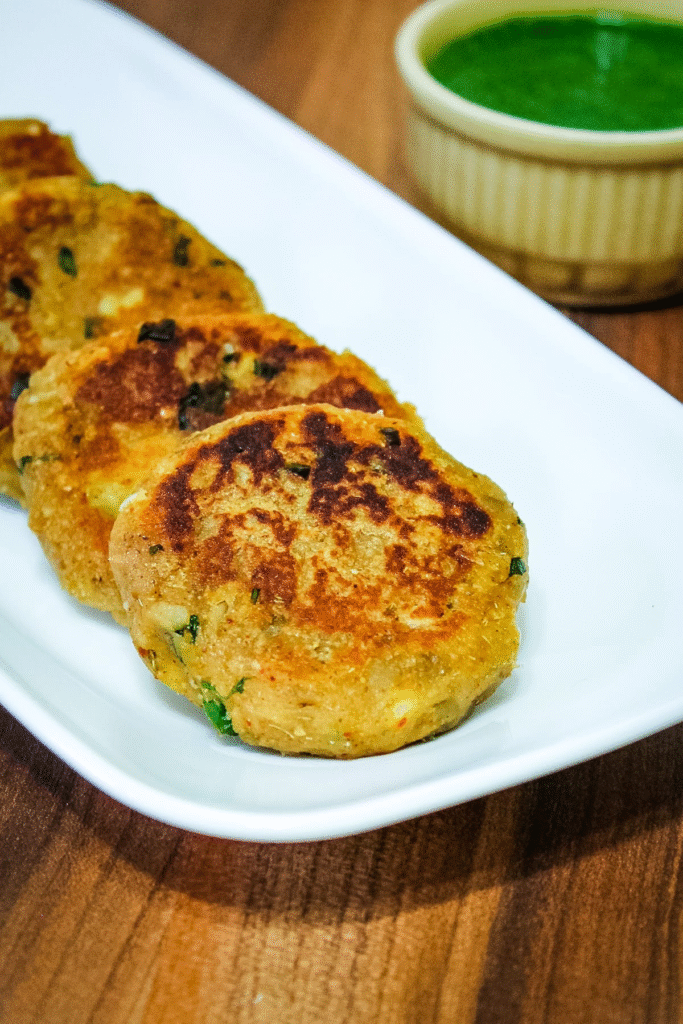Sweet Potato Tikki is a wholesome and flavorful snack that’s especially popular during Hindu fasting days such as Navratri, Ekadashi, Mahashivratri, or other vrat (upvas) occasions. Made using boiled and mashed sweet potatoes, this dish offers a naturally sweet taste balanced with subtle, warm Indian spices. The mixture is gently spiced using ingredients like rock salt (sendha namak), crushed black pepper, cumin, and green chilies, which are all permissible during fasting.
Once the mixture is well combined, it is shaped into small round patties or tikkis and shallow-fried in ghee or oil until golden and crispy on the outside, while remaining soft and melt-in-the-mouth on the inside. These tikkis are not only delicious but also nutrient-dense, gluten-free, and easy to digest, making them ideal for fasting days when the body requires light yet energizing meals.
You can serve these sweet potato tikkis with vrat-friendly accompaniments like farali green chutney (made with coriander, mint, and peanuts) or a bowl of chilled yogurt. They also work wonderfully as a light evening snack or appetizer. Rich in fiber, antioxidants, and complex carbohydrates, this dish is a perfect blend of health, tradition, and flavor, making your fasting meal satisfying and festive
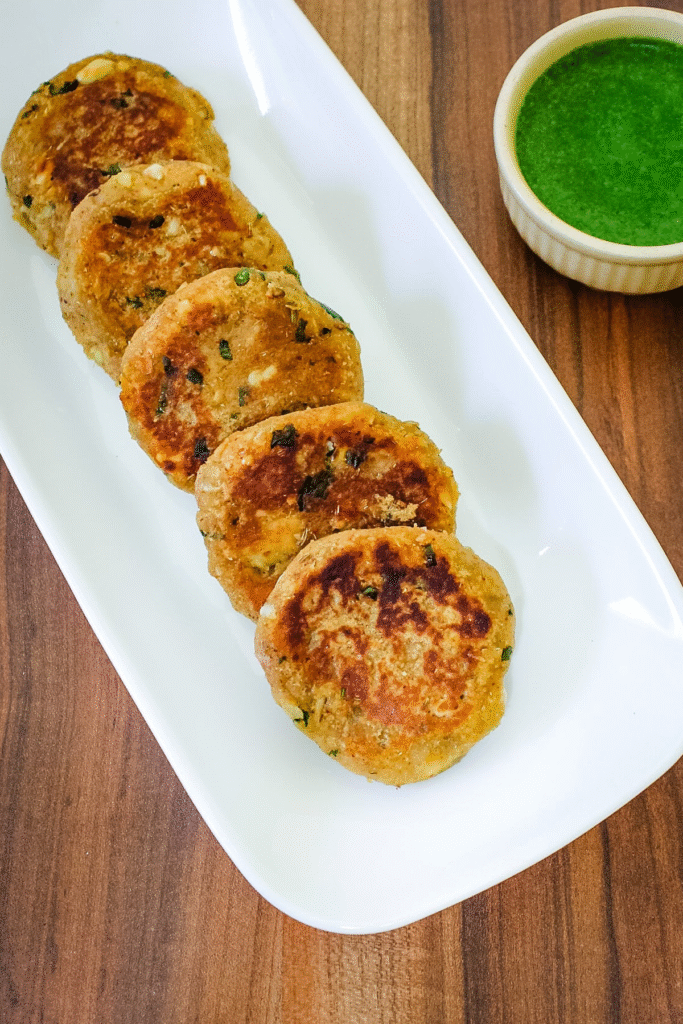
❤️ About This Sweet Potato Tikki Recipe
During the auspicious days of Navratri fasting or vrat, most people follow a strict satvik diet that excludes grains, onion, garlic, and common salt. In such times, farali or vrat-friendly dishes become the norm. One of the most used ingredients during these days is the humble potato—boiled, mashed, fried, or sautéed. While undeniably versatile, eating potatoes in every meal can get repetitive. That’s when sweet potatoes come to the rescue as a refreshing and nutritious alternative.
Sweet potatoes (shakarkand) not only bring a natural sweetness and vibrant color to your dish but are also packed with fiber, vitamins, and antioxidants, making them a healthier choice during fasting. These sweet potato tikkis break the monotony of regular vrat meals and introduce a subtly sweet and earthy flavor profile that pairs beautifully with Indian spices permitted during fasting, such as sendha namak (rock salt), roasted cumin, and green chili.
These tikkis are shaped into small, flat round patties and shallow-fried until golden brown and crispy on the outside while remaining soft and melt-in-the-mouth from within. What makes them even more appealing is that they are naturally vegan and gluten-free, making them suitable for people with specific dietary needs.
You can enjoy these sweet potato tikkis as a light evening snack with a cup of hot masala chai or coffee. They also pair wonderfully with vrat-friendly chutneys like coriander-peanut chutney or coconut chutney. And if you ever feel like switching it up, the same recipe works just as well with regular potatoes—just call it aloo tikki instead. Either way, this recipe is a delightful addition to your Navratri menu, bringing both taste and nourishment in every bite.
🧾 Ingredient Notes
This photo showcases the ingredients used in making sweet potato tikki — all of which are everyday staples found in Indian kitchens. There’s nothing exotic here, just simple, familiar items that bring rich flavor and comfort.
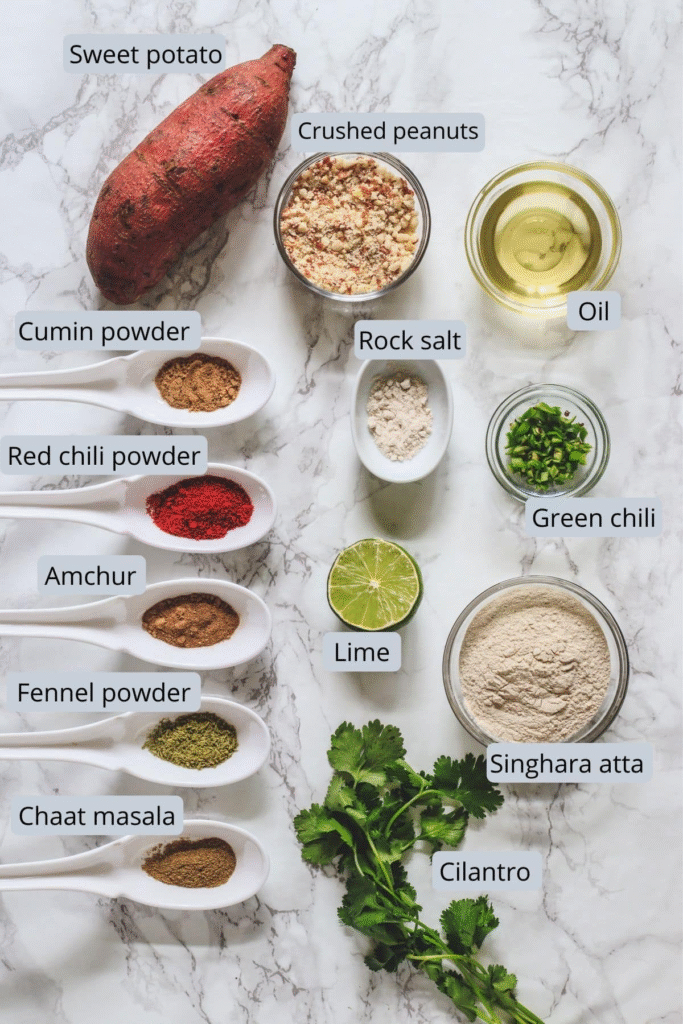
- Sweet Potatoes: I’ve used the Indian variety of sweet potato which has a creamy white interior and naturally sweeter taste. If you’re using the more commonly found orange-fleshed sweet potatoes available in Western stores, keep in mind that they are slightly less sweet and may give a different flavor profile—but they still work well in this recipe.
- Singhare ka Atta (Water Chestnut Flour): This is one of the key flours used during Hindu fasting periods. It not only helps bind the tikki mixture but also absorbs excess moisture, making it easier to form patties. If you don’t have singhare ka atta, alternatives like rajgira atta (amaranth flour) or kuttu ka atta (buckwheat flour) are also commonly used for vrat. For regular (non-fasting) days, you can replace it with rice flour or ground oats.
- Sendha Namak (Rock Salt): Since regular iodized salt is typically avoided during fasts, rock salt is used instead. It’s easily available in Indian kitchens during festive fasting times and adds the needed seasoning without breaking any vrat rules.
- Chaat Masala: I prefer using homemade chaat masala made especially for fasting days—prepared by my mom without the usual table salt. Be cautious with store-bought versions, as many of them contain regular salt which is not allowed during vrat. You can skip it altogether or check the ingredients carefully before using.
- Lemon or Lime Juice: A dash of fresh lemon or lime juice brightens up the flavor and cuts through the natural sweetness of sweet potatoes, giving the tikkis a well-balanced, tangy kick.
👩🍳 How To Make Sweet Potato Tikki? (Pics)
1) Wash and scour the sweet potatoes well and get freed of the earth. take into a pressure cooker with sufficient water so they are submerged in the water. Cover the cover, put the weight on and cook it on medium warm for 5-6 shrieks. The number of shrieks and cooking time simply depends on the estimate of the sweet potato, so cook accordingly.
2) Let the pressure go down by itself, deplete all the water and let them cool to touch. At that point expel the skin.
3) Squash it truly well utilizing a potato masher.
4) Include rest of the tikki fixings (amchur powder, chaat masala, cumin powder, red chili powder, fennel seeds powder, sendha namak, green chilies, cilantro clears out, lime juice and pulverized peanuts). Blend everything well.
5) Include singhare ka atta.
6) Blend and make a batter ball. The amount of the flour depends on the sweet potato sort and how much dampness is show in it. As it were include sufficient flour so that you are able to frame the tikkis.
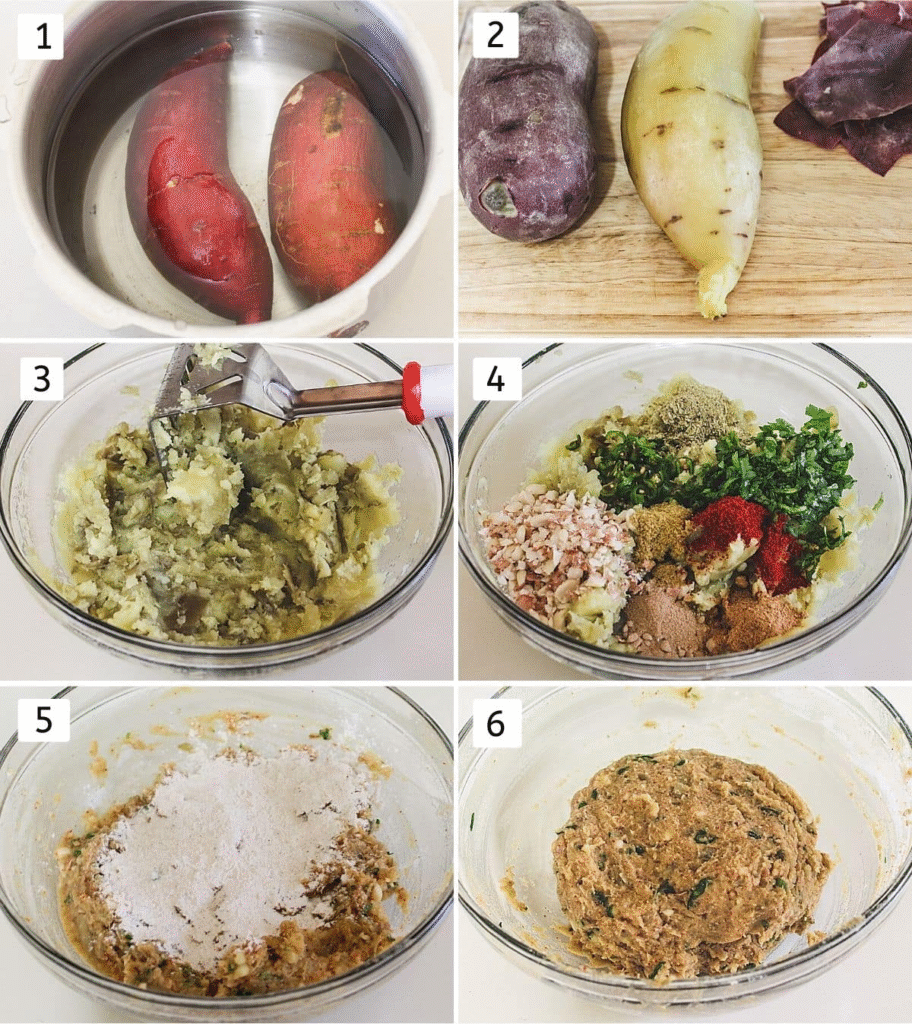
7) Presently oil your hands with oil or ghee. and begin forming the tikkis.
8) Shape all the tikkis.
9) Warm a few tablespoons of oil in a nonstick skillet on medium warm. Once hot put the tikkis and fry
10) Once get light brown from the foot side at that point flip it and cook another side as well. Evacuate it to a plate and serve.
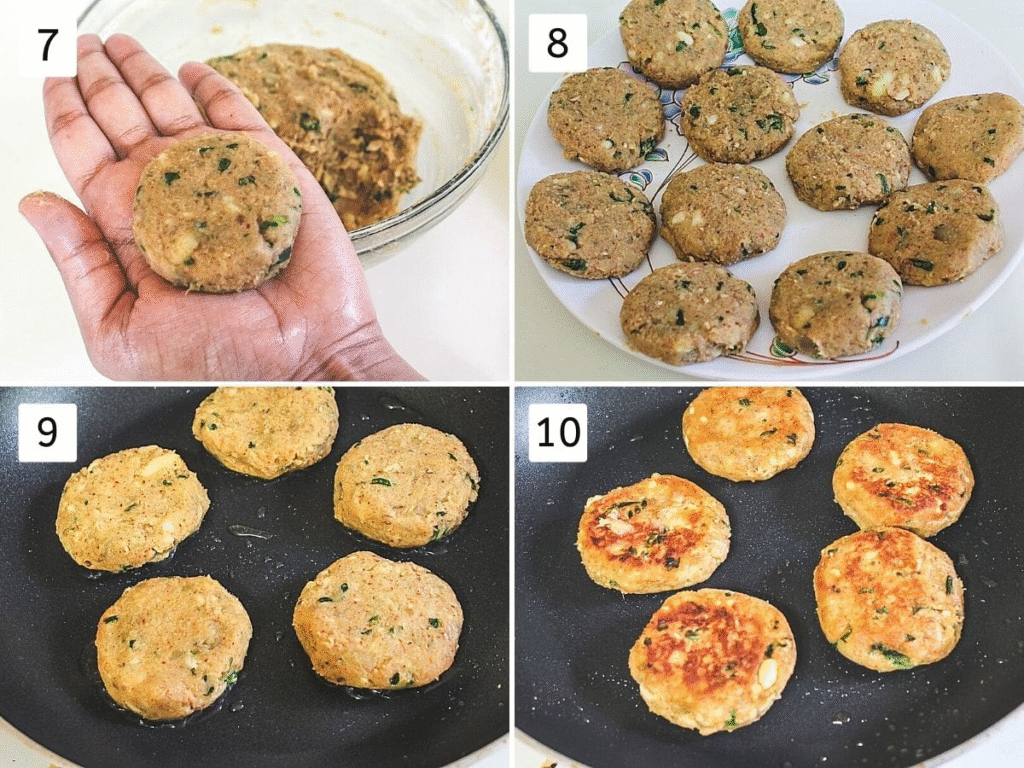
💭 Expert Tips
- Cooking Methods for Sweet Potatoes: You can cook sweet potatoes using different methods based on your convenience. For a hands-free and efficient method, use the Instant Pot—set it on manual mode for about 15 minutes. Alternatively, you can roast or bake the sweet potatoes in a preheated oven until they turn soft and tender. Baking brings out the natural sweetness and helps reduce excess moisture compared to boiling.
- Avoid Overcooking: Be cautious not to overcook the sweet potatoes, especially when boiling. Overcooked sweet potatoes tend to absorb more water, making them too soft and mushy. This excess moisture can make it difficult to bind the mixture, and the tikkis might break or lose shape while cooking.
- Flour Quantity May Vary: The amount of binding flour, such as singhare ka atta (water chestnut flour), rajgira atta (amaranth flour), or kuttu ka atta (buckwheat flour), depends entirely on the moisture level in your mashed sweet potatoes. If your mixture feels too sticky, gradually add more flour until the mixture is pliable enough to shape.
- Storage and Make-Ahead Tips: These tikkis can be prepared ahead of time for convenience. Once shaped, arrange them on a tray and freeze until firm, then transfer to a ziplock bag or airtight container for longer storage. You can shallow fry them straight from the freezer—no need to thaw. Alternatively, if making them just a day or two in advance, place the shaped tikkis on a plate, cover them tightly with cling film or store in an airtight container, and refrigerate. Shallow fry them just before serving for best texture and flavor.
🍽 Serving Ideas For Sweet Potato Tikki
- During Fasting Days (Vrat/Upvas): These sweet potato tikkis make an ideal snack or light meal option during fasting periods like Navratri, Ekadashi, or Shravan. Serve them warm with farali green chutney made using ingredients allowed during fasting such as fresh coriander, green chilies, rock salt (sendha namak), lemon juice, and roasted peanuts. You can also pair it with a yogurt-based dip for a cooling contrast.
- On Regular Days: When not fasting, you can enjoy these tikkis with a wide variety of regular condiments. They taste great with classic green chutney (made with coriander, mint, garlic, and lemon juice) or tamarind-date chutney for a sweet and tangy kick. They also pair well with tomato ketchup, garlic chutney, or even mayonnaise for kids or those who prefer a milder taste.
- Make a Chaat Out of It: Transform your sweet potato tikkis into a delightful and flavorful chaat on non-fasting days. Place the crispy tikkis on a plate, slightly crush them and top with spoonfuls of green chutney (cilantro-mint), sweet tamarind-date chutney, and spicy red garlic chutney. Add finely chopped onions, tomatoes, and a sprinkle of chaat masala for extra zing. Garnish generously with sev, fresh coriander leaves, and optionally a dollop of whisked curd for a creamy texture. This makes a colorful, tangy, and absolutely lip-smacking street-style snack that’s perfect for evenings or as a party appetizer.
